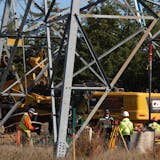Opinion editor's note: Editorials represent the opinions of the Star Tribune Editorial Board, which operates independently from the newsroom.
•••
ST. LOUIS, Mo. — The light-rail system in the St. Louis area is second only to that in the Twin Cities area as the largest in the Midwest, with two lines and 38 stations that span two states. Like the Twin Cities, St. Louis also faced issues with rising crime and declining ridership that predated the pandemic.
After a series of violent crimes, leaders here took decisive action starting in 2018. They zeroed in on one element above all else: rider safety. The overhaul that followed changed the city's entire approach, with a single-minded, unapologetic, safety-first mindset that has resulted in a far more visible security presence, from police and other staff on trains to better use of technology.
The final phase is in progress now: a potentially groundbreaking conversion from the open "honor" system, like the one used in the Twin Cities, to one in which gates and fences ensure that only paid passengers have access to platforms and trains. The $52 million project includes a rarity in transit: a public/private partnership in which major downtown corporations are putting up $10 million to help fund the conversion.
Leading that effort has been Taulby Roach, CEO of Bi-State Development, the organization overseeing mass transit and an LRT system that runs from Missouri into Illinois — the only light-rail system in the country to cross state lines. Practically speaking, that means that a number of governmental entities must come together on anything of significance. In the two states, that includes three separate local jurisdictions and their law enforcement agencies.
How did Roach and others gain consensus from such disparate entities? "Well, it wasn't butterflies and rainbows that got us there," he said with a pained smile. The light-rail system, called MetroLink, was coming off two homicides just a month apart in 2017, and passengers were complaining about witnessing drug deals, smoking on trains, various crimes and ongoing harassment and threats — safety issues familiar to Twin Cities LRT riders.
"We had a problem to solve," said Roach, who took over in 2019. Despite multiple frustrations, he said, "you had to reach the point of 'We care about our communities, so what are we going to do about it?'"


